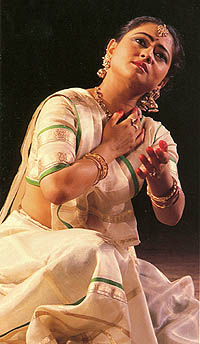INTRODUCTION
The classic texts of Ancient India even today are the standard to evaluate a
performance of dance. Every dance form has the distinctive features of a region
it belongs to. The principles of Natyashastra
 are
treated in different dance styles respectively especially in relation to
positions, movements and gestures. Fortunately, the sufficient amount of basic
material on dance styles has been collected and universally recognized among
gurus, dancers and disciples of all styles and schools. are
treated in different dance styles respectively especially in relation to
positions, movements and gestures. Fortunately, the sufficient amount of basic
material on dance styles has been collected and universally recognized among
gurus, dancers and disciples of all styles and schools.
All forms of Indian classic dance have two main aspects: nritta and nritya.
Nritta can be characterized as a pure dance i.e. abstract body movements
harmonized with hastas or hand gestures.
Nritya is a combination of pure and plot dance. A plot dance should be
distinguished from pantomime. This is not just an imitation of human behavior.
Depending in many ways on the accompanying lyrics, nritya broadly uses hastas
each one transferring a certain meaning. Besides nritta and nritya there is the
third aspect in dance tradition.
This is Natya i.e. performance with or without dance. Generally and strictly
speaking this is a kind of dramatic art.
All three aspects were considered closely connected with each other and
originated in one tradition. Many elements of dance indeed appeared not from
strict following classic texts but were passed down from generation to
generation through the tradition of a theatrical performance.
In Natya ideas and emotions find their expression in the art of abhinaya. A
skillfully selected facial expression (especially that of eyes) in combination
with the appropriate lyrics recitation gives an actor the opportunity to render
moods which can be sthayi (permanent) or viabhichari (transitional).
Abhinaya may be lokadharmi (realistic) or natyadharmi (stylized).
Dancers portray bhava and rasa. These terms are not easy to interpret. The
Sanskrit word "bhava" denotes an emotion and its external expression. The term "rasa"
besides literally meaning "tinge" or "feeling" also renders the same aesthetical
and emotional perception of the portrayed mood both on a performer's and
spectator rasika or taster's parts.
If abhinaya is played with a feeling then a dancer without resorting to the help
of words may provoke in rasika the understanding and empathy for the ideas and
feelings put in a dance.
Rasa or an aesthetical feeling is stirred up by sthayi-bhava (permanent state)
of a pleasant feeling with the help of unintentional and transitional (viabhichari)
states. Rasa is an answer to bhava. If spectators apprehend bhava it causes in
them rasa or the enjoyment of bhava. In order to arouse the continuous flood of
rasa or aesthetical delight, a dancer must constantly keep up the high level of
expressiveness.
Bhava gives birth to nine classical rasas or "tinges": Shringara (erotic), Hasya
(comic), Karuna (pathetic), Vira (heroic), Raudra (terrible), Bhayanaka (timorous),
Bibhasta (disgusting), Adbhuta (magic) and Shanta (pacifying).
Shringara or erotic feeling is the most all-embracing among all the rasas. Any
other rasa appears either as a transitional state of shringara or interflows
with it. It is interesting that every rasa is traditionally associated with the
opposite rasa, with a color, with one of the supreme gods, with a certain note (svara)
and with purushartha or with a rasa's meaning for four phases of human life:
dharma (duty), artha (wealth), kama (desire) and moksha (liberation).
They say that a dancer's portrayal of a certain rasa can be equated with the
dancer's actual experiencing of the respective phase of life and that every
performance brings him/her closer to the highest purpose, moksha or liberation
from the chain of births.
| 